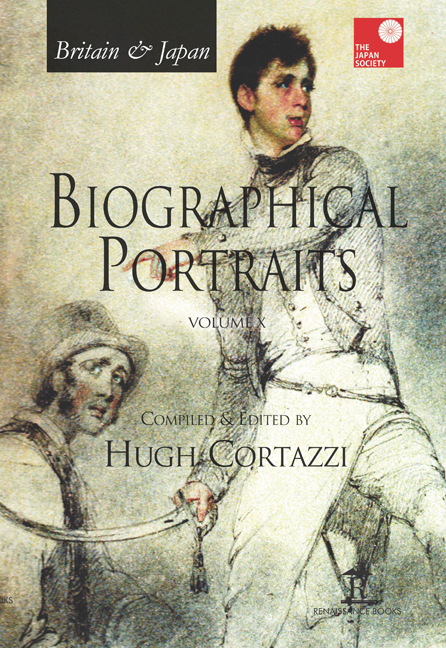Book contents
- Frontmatter
- Dedication
- Contents
- Introduction
- List of Contributors
- Index of Biographical Portraits in Japan Society Volumes
- PART I BRITAIN IN JAPAN
- PART II JAPAN IN BRITAIN
- Select Bibliography of Works in English on Anglo-Japanese Relations [Compiled by Gill Goddard – Retired East Asian Studies Librarian, University of Sheffield]
- Select Bibliography of Works in Japanese on Anglo-Japanese Relations [Compiled by Akira Hirano, SISJAC]
- Index
18 - Earl of Kimberley (1826–1902) and Japan
Published online by Cambridge University Press: 07 May 2022
- Frontmatter
- Dedication
- Contents
- Introduction
- List of Contributors
- Index of Biographical Portraits in Japan Society Volumes
- PART I BRITAIN IN JAPAN
- PART II JAPAN IN BRITAIN
- Select Bibliography of Works in English on Anglo-Japanese Relations [Compiled by Gill Goddard – Retired East Asian Studies Librarian, University of Sheffield]
- Select Bibliography of Works in Japanese on Anglo-Japanese Relations [Compiled by Akira Hirano, SISJAC]
- Index
Summary
INTRODUCTION
HISTORY HAS TREATED the Earl of Kimberley with the condescension with which it has treated most Victorian politicians – it has forgotten him. In part, his posthumous obscurity reflects his public persona. Removed from the bustle of the House of Commons, he spent much of his career in the more sedate atmosphere of the upper chamber. The inaccessibility of his private correspondence, meanwhile, further prolonged his shadowy historiographical existence. It was only very recently that Kimberley's historical persona has been retrieved from the abyss into which it had fallen. This is not to reclaim him as a ‘lost Foreign Secretary’. His one brief spell at the Foreign Office does not allow for that. Kimberley's political career was nevertheless remarkable for its longevity and proximity to the ‘inner group of the Cabinet’. For nearly thirty years, from 1868 until 1896, he served in every Liberal administration, and his name was frequently touted in connection with various high offices whenever a new Cabinet was formed or a reshuffle was on the cards. His fifteen months as Foreign Secretary, from March 1894 until the collapse of the Earl of Rosebery’s government in June 1895, were the culmination of a long career, much of which involved imperial and foreign affairs.
CAREER
John Wodehouse (1826–1902), since 1847 3rd Baron Wodehouse, and from 1866 1st Earl of Kimberley, was born into a long-established Norfolk Tory gentry family, but became a Whig while still at Eton. Having served as Earl Russell's Parliamentary Under-secretary at the Foreign Office for four years after 1852 (and again, 1859–61), he was appointed minister plenipotentiary to Russia at the end of the Crimean War. In that role he was a doughty defender of Lord Clarendon's firm policy of containment. Political rewards eventually came his way and after 1868, he occupied senior Cabinet posts whenever his party was in office. From the sinecure of the Privy Seal he was moved, in 1870, to the Colonial Office where he remained until 1874, returning to it in 1880, before assuming the seals of the India Office two years later. Kimberley held the India portfolio on three occasions (1882–5, 1886 and 1892–4). He was something of ‘an “Imperial handyman”’. The boundaries between imperial and foreign affairs were not always clearly drawn from the 1880s onwards, and Gladstone frequently conferred with Kimberley on matters, which fell more properly into the remit of the Foreign Office.
- Type
- Chapter
- Information
- Britain & Japan Biographical Portraits Vol X , pp. 208 - 220Publisher: Amsterdam University PressPrint publication year: 2016

